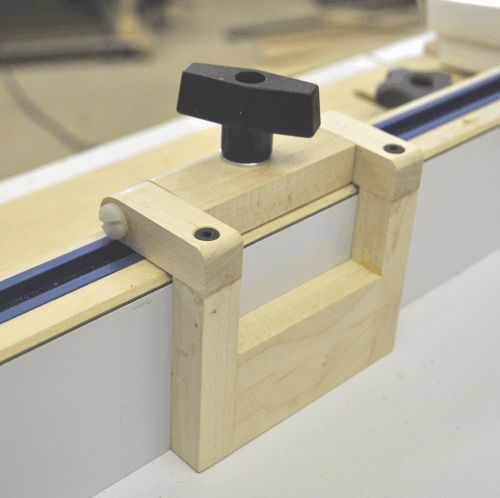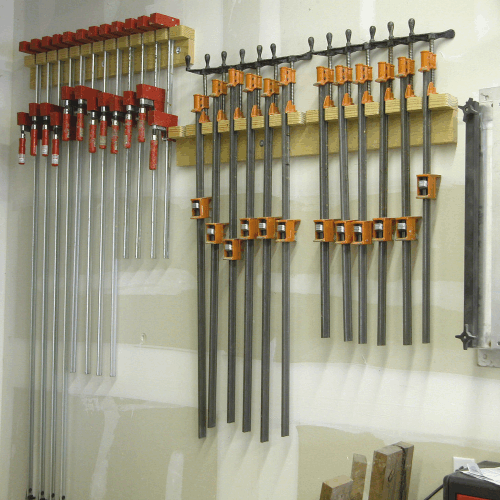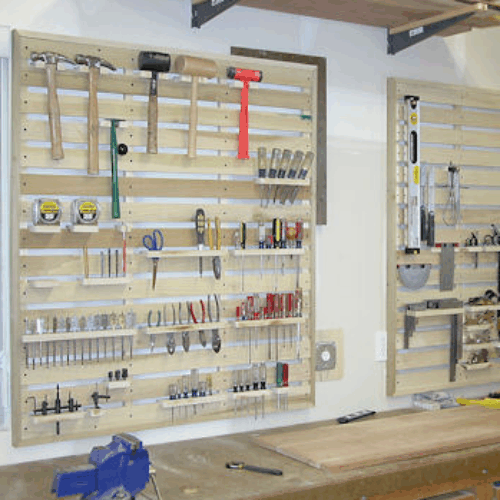Buy Quality Tools
Starting out in woodworking? Don’t forget this basic tip….Buy quality tools! This doesn’t mean you have to buy the most expensive tools. Get input from woodworker’s who have been at it for a while. For example, one of the worst mistakes you can make is to buy a cheap table saw that is underpowered and has a a poorly constructed fence. Not only will you be frustrated because it doesn’t have enough power to cut the material you are using, but the lack of power along with a fence that won’t stay parallel with the blade is an accident waiting to happen. A table saw with a bigger table also provides better support for the material you are trying to cut. This same example can be applied to most woodworking tools from power to hand tools. If you sacrifice accurate tools for cheap inaccurate tools, your woodworking experience won’t be pleasant.
Measuring

Measuring can make or break a woodworking project. Through away those big carpenter pencils. Those are for rough framing a house or the like. Use a good #2 lead pencil that you can sharpen to a fine point. Next measure as shown in the illustration below. Make a “V” mark. The tip of the “V” should be the exact point of measurement. This will give you confidence in the point marked versus having just a straight line mark which makes you question the exact point of measurement. A “V” mark makes it much easier to align a square for marking a complete line or, if you choose to just cut the mark on a miter saw, it’s much easier to align your saw tooth to the point of the “V” versus a straight line. For some woodworking projects where you have multiple pieces that should be the same size, the exact length or width of piece may not be as important as having the multiple pieces the same exact size.
Plug Cutters
 Don’t try to putty those counter sunk screw holes. It will never look professional. Get yourself a screw countersink set with matching plug cutters or you can just buy a separate set of plug cutters to match the size of your countersink set or your drill bits if that is all you are using. Cut the plugs from the same type of wood you are using and, if you are really particular, align the grain on the plugs in the same direction as the grain on the board where you counter sank the screw. Glue the plug in place, leaving plenty of plug above the board surface. After it dries, hit the plug with your orbital or finish sander and whoohoo!!!…you can hardly see the countersunk screw hole.
Don’t try to putty those counter sunk screw holes. It will never look professional. Get yourself a screw countersink set with matching plug cutters or you can just buy a separate set of plug cutters to match the size of your countersink set or your drill bits if that is all you are using. Cut the plugs from the same type of wood you are using and, if you are really particular, align the grain on the plugs in the same direction as the grain on the board where you counter sank the screw. Glue the plug in place, leaving plenty of plug above the board surface. After it dries, hit the plug with your orbital or finish sander and whoohoo!!!…you can hardly see the countersunk screw hole.
Dust Collecting
Dust collection is an important aspect of the beginner’s woodshop. You won’t be very popular if you are constantly tracking sawdust through the house nor will some of your tools work properly without a good dust collection system. For example, if you have a bench top or other thickness planer, it won’t work well without a good dust collecting system to draw the shavings away from the machine. This likewise applies to a joiner, drum or belt sander, and router table. Please Note: With any dust collecting system, the most important thing to maintain a ground between the machine being used and the dust collection system. Without this ground wire, you could cause a major fire in your shop and risk everything connected to your shop (like your house!). We suggest using metal gates and metal connectors at the woodworking machinery end. Buy the clear plastic dust collecttion hose with the spiral wire that you can see going through it. This can easily be grounded at each end of the hose to the metal gates and connectors. You can use all plastic gates, connectors, and hoses but then you have to run a wire from the woodworking machine to the dust collector. This is very cumbersome and usually lessens the possibility of having a grounded connection because of the frequency in moving the end of the dust collection hose that attaches to various woodworking machines. Check out the dust collection system pictures on Dave’s Woodshop on this site. This Oneida-Air system is a great system but will cost you about $1,500 and $2,000 dollars. The air bags allow no visible dust to escape, the system is relatively quiet, and has a lot of suction. For the beginner, you might be better off starting with a portable system on wheels. These can be purchased anywhere from $200 to $1,000. The important thing is you get one that doesn’t allow the fines to be discharged back into the room. These system can also be frustrating because you are constantly emptying them, and the filters or bags have to be cleaned frequently. This is not the case with the one shown in Dave’s Workshop. You also don’t need all of that automatic gate stuff which opens when you turn your machine on unless you have a lot of extra money. If you have a small workshop the size of a single car garage, a centrally located dust collection port(s) with manual gates will work great. For a few hundred dollars you will even be able to buy a remote control to turn your system on when you are ready to make some sawdust.
Table Saw Fence Clamps
To protect the face of your table saw fence (as well as your saw blade), it works great to clamp a face board along your table saw rip fence. A face board also gives you a lot of flexibility when you are cutting dados and want the dado blade to be recessed into the face board. Using normal c-clamps to hold the fence board board on is cumbersome because you have to clamp onto the face of the board and the clamp ends up getting in your way. The clamps shown below from Rockler work great for this. As you can see, you drill a hole in the top of the board to hold the fence on so you have nothing protruding past the face board.
Clamping Small Boxes/Frames
Clamping small boxes or pictures frames can be tricky. Most corner clamps are too big to fit the small boxes or frames. You can buy strap clamps which work well for this purpose because the strap pulls all the sides in equally and aligns the corners at the same time. The only thing you have to do is make sure the top of the box/frame is flush. The other thing that works well is to use rubber bands. The bigger the project the bigger the rubber band needed. Any time you run across huge rubber bands, hide them in your shop before your spouse uses or disposes of them. The sharp corners of your project can sometimes cut the rubber band will it will break. If you want to buy some good rubber bands made for this purpose, you can go to the link below. Otherwise, just keep saving those big rubber bands.
Miter Saw Cuts
Every beginning woodworker needs a good miter saw. If you don’t buy a compound miter saw, you will wish that you had. Here’s some safety precautions when using a miter saw. Make sure the saw is mounted or clamped to a flat even surface. You don’t want it jumping around on you while cutting. Use extreme caution when cutting warped or twisted material. If it doesn’t lay flat on the miter saw table it’s probably going to cause problems. Likewise, if the material doesn’t slide all the way back against both sides of the miter saw back fence, you’re asking for trouble. Many a woodworker have bent their miter saw fence and been scared to death from the noise made when the warped board you’re trying to cut slams against the fence. You can make small partial cuts on the sides or top trying to get it to lay flat but that can be dangerous because the saw will grab the material when least expected. The best advice for beginners is to not buy or work with warped material until you become more experienced in how to true such material up on your table saw/thickness planer. Likewise, make sure you are using a sharp miter saw blade.
Using Wood Glue
Using wood glue is an art in itself. The best advice is to be neat and don’t use too much glue. Spread a thin coat on both surfaces to be glued. Of course, the experienced woodworker knows that the best and most convenient tool for spreading glue is your finger (woodworkers don’t pick their noses, they pick glue off their finge Some prefer a putty knife or a small stiff brush. If you are gluing big areas, spread the glue a bit thicker and use a wide putty or drywall knife. Try to keep the glue off of the surfaces that you will be finishing (although this is mostly impossible). The less you get on the surfaces you will be finishing that easier the sanding becomes. The most important gluing tip is to not wipe the glue off of any of the surfaces to be finished. This will just spread the glue into the grain of the wood and sanding will be much more difficult. The easiest way to remove the excess glue is to let it dry and then use a good glue scraper to remove it before it is completely dry. Waiting 3-4 hours before scraping is a good rule of thumb. Want a few laughs…..take a look at the wood glue post in “Life in Pappy’s Woodshop”.
Sharpening Router Bits
Sharpening router bits isn’t talked about much in the woodworking world but it’s just as important to sharpen them as it is to sharpen chisels or planes. It take a little practice and some router bits are easy to sharpen while others are much more difficult. You’ll need a diamond paddle. Lay the diamond paddle or file on the flat face of the flute. Hold it lightly but tight enough that you can feel that it is laying flat against the flute then give it 4-6 strokes up and down. Move to the next flute and give it the same number of strokes. Keep this process going until you feel the router bit is sharp. By keeping the bit rotating and giving each flute the same number of strokes will insure it is sharpened evenly. Don’t try sharpening the outside edge of the flute because that will change the profile. Congratulations, that’s all there is to it!
Using Pipe or Bar Clamps
Using pipe or bar clamps is much easier if you plan ahead…and there are a number of things to plan for. Do a dry clamp run! This will force you to space the clamps properly and let you know if your work piece is going to bow up or down while being clamped. If you are using biscuits, it’s wise to put the biscuits in the dry run as well because you might have cut the biscuit slot in the wrong place. If you care about the outside edges contacting the clamps, put a strip of wood there to avoid damaging the edge of the work piece. You might want to make a jig or put spacers under your clamps because the handles on a lot of pipe and bar clamps tend to hit the surface they are sitting on which makes tightening them more difficult. It is very important that all pieces being clamped together sit flat against the pipe or bar on the clamps. If the boards tend to bow up or down during the dry clamp run, you might want to recruit a second person to stand on the boards so they lay flush against the pipe or bar before tightening the clamp. When you are ready for the final clamping, spread glue on both surface being clamped together. Don’t overdue it with the glue because it will make it more difficult to clean off the board surface. Most importantly, do not wipe the glue off the glue joint. Let it bead up and dry sufficiently then use a glue scraper to remove the beads. Wiping the glue off will push it into the wood grain and it won’t take stain without heavy sanding.






